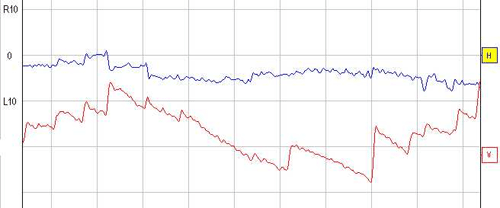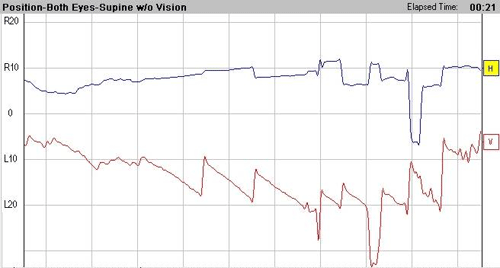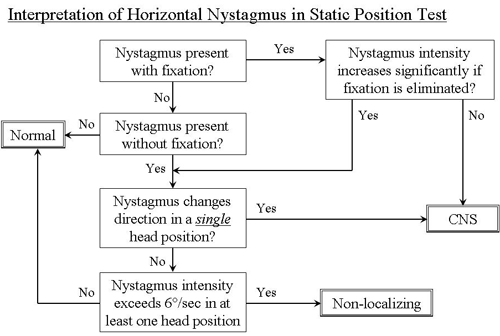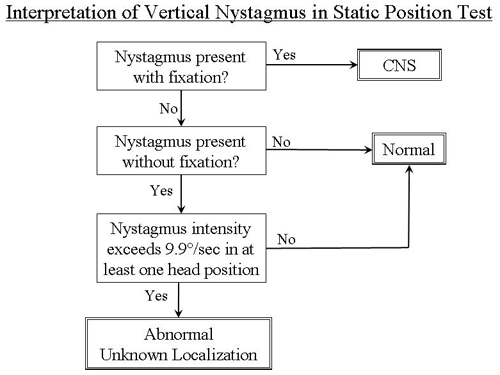There are considerable differences in the literature on how to perform and interpret the position test in the ENG test battery (Brandt, 1993). Although consensus has been reached on many aspects of the test (Mullen and Gianoli, 2001), new and controversial issues have emerged, especially with the advent of videonystagmography (VNG). In this article, I will describe how we perform and interpret the position test in our laboratory and will discuss the current controversies.
The position test consists of two parts, static and dynamic position tests. They are usually referred to in the literature as positional and positioning tests, respectively (Barber and Stockwell, 1980). The latter includes Hallpike and other provocative maneuvers. In the static position test, the examiner looks for nystagmus that is present as long as the head remains in a critical position. In the dynamic position test, the examiner looks for transient nystagmus that appears when the head is moved to a critical position but dissipates over time as the head remains in that position. The focus of this article is on the static position test.
Performing the Test
The following issues should be considered when performing the static position test:
Head positions
On routine testing, we include the following head positions:
- Sitting - The patient sits with the head upright. Since the gaze test is also performed in this position, the results can be used to verify the consistency of the overall ENG/VNG test.
- Supine - The patient is placed supine with the head flexed forward approximately 30º. This is the standard caloric position and is preferable to the patient lying flat.
- Head right - From the supine position, the head is turned right. If patients experience neck discomfort, do not force them to turn their head too far. Instead use one of the alternative positions described below.
- Head left - From the supine position, the head is turned left. Again, use the alternative positions if neck rotations cause any discomfort.
The following two positions are included in the static position test if nystagmus characteristics change significantly when the patient is moved from supine to head right or head left positions. - Body right - From the supine position, the entire body is turned right.
- Body left - From the supine position, the entire body is turned left.
If patients complain about a particular head position that provokes their symptoms, we include that position in the test battery. We do not test the patient with the head hanging in the static position test but include that in the dynamic position test. In our experience, testing in other head positions does not provide additional clinical information.
Fixation
Static position testing is performed without fixation. As with any other test that is performed without fixation, the patient must be alerted throughout the test (Barber and Stockwell, 1980). When the patient has nystagmus in any head position, repeat the test with fixation. This allows the examiner to determine the effect of fixation on the nystagmus.
Duration of recording
For each head position, eye movements should be recorded for at least 20 seconds or as long as necessary for the examiner to determine with certainty the presence or absence of nystagmus. In our laboratory, we begin the recording before moving the head to a new position. As a result, transient nystagmus such as those seen in patients with benign paroxysmal positional vertigo (BPPV), can be recorded. It is important for the examiner to continue recording eye movements until the transient nystagmus subsides and the presence or absence of nystagmus due to the static head position can be determined.
Periodic alternating nystagmus is a rare abnormality where the nystagmus direction changes in a single head position (Baloh and Honrubia, 1990). The change in the nystagmus direction occurs approximately every two minutes. To observe this abnormality, it would seem that the examiner has to record the nystagmus for two minutes or longer in each head position. However, this is impractical and will make the static position test unnecessarily long. Instead, the examiner should be watchful of any contradictory finding that may suggest the presence of periodic alternating nystagmus. For example, the nystagmus direction in the gaze test without fixation should be the same as the nystagmus direction in the sitting position. Also, any nystagmus that is present at the beginning of a caloric irrigation usually corresponds to pre-existing nystagmus in the supine position. Since the head position is the same, the direction of pre-existing nystagmus is expected to be the same for different irrigations. Differences in these nystagmus directions may suggest the presence of periodic alternating nystagmus. If so, the examiner should repeat the static position test and record long enough to determine if the nystagmus is changing direction in a single head position.
Analyzing the Test
After performing the test, the examiner should carefully inspect the recordings for evidence of nystagmus. Nystagmus in position testing can have many different characteristics. Accurate interpretation of the test requires the examiner to identify these characteristics and differentiate among different types of nystagmus.
Direction
Nystagmus can be horizontal, vertical, torsional, or a combination of those. Up until recently, interpretation of static position testing was limited to horizontal nystagmus because ENG is insensitive to torsional eye movements and the vertical channel is often noisy and contaminated by eye blinks. There have been more reports of vertical nystagmus with the increase in using VNG (Sunami, et al, 2004). We should now consider vertical nystagmus in the interpretation of static position testing. Although torsional nystagmus is a common component of BPPV-type nystagmus, so far there are very few reports of non-transient torsional nystagmus in the static position test. Therefore, we currently limit our interpretation to horizontal and vertical nystagmus.
Typically, nystagmus is characterized by its fast phases but some laboratories describe the direction on the basis of slow phases. To eliminate any ambiguity, the examiner should be clear as to which phase is being described. Adding the term beating to the direction signifies fast phases.
In addition to the direction of the nystagmus in each head position, the examiner must note any change in the nystagmus direction in different head positions. The case of periodic alternating nystagmus was discussed in the previous section. For horizontal nystagmus, one of the more common findings in the position test is the nystagmus that has essentially the same direction and intensity in different head positions. This is manifestation of the so-called spontaneous nystagmus in the position test. It is called spontaneous nystagmus because it is present in the absence of any visual or motion stimulation. A similar type of nystagmus has the same direction but its intensity varies from one head position to another. This is sometimes called positional nystagmus to differentiate it from spontaneous nystagmus. Spontaneous nystagmus and positional nystagmus are examples of direction-fixed nystagmus. Two types of direction-changing horizontal nystagmus are geotropic and ageotropic (apogeotropic). In geotropic nystagmus, nystagmus beats right in the head right position and beats left in the head left position. Conversely, nystagmus beats left in the head right position and beats right in the head left position for ageotropic nystagmus. Direction-changing nystagmus that is present only in the head/body right and left positions is uncommon. Instead, there is usually nystagmus in sitting and supine positions and turning the head/body generates geotropic or ageotropic effect. Except for periodic alternating nystagmus, it is extremely rare for horizontal nystagmus to beat in different directions in sitting and supine positions.
As noted before, vertical nystagmus is difficult to identify in ENG. Sometimes, the combined effect of eye blinks and filtering in the ENG equipment can resemble vertical nystagmus in the tracings (Barber and Stockwell, 1980). For example, Figure 1 appears to demonstrate upbeat nystagmus. To determine if this is an artifact or true vertical nystagmus, the examiner should repeat the test while the patient wears Frenzel goggles. In the case of vertical nystagmus, the examiner can visualize it with Frenzel goggles. In VNG, video recordings provide an ideal method for visualizing the nystagmus and measuring its parameters. We have two examples to demonstrate this, Video 1 and Figure 2. In these examples the nystagmus is oblique with both horizontal and vertical components.
Video 1. Vertical nystagmus without fixation. Note: The video is in Windows Media Video format. You must have the free Windows Media Player (microsoft.com) installed to view the video.

Figure 1. Eye blinks resembling upbeat nystagmus.

Figure 2. Vertical nystagmus without fixation.
Crosstalk should be ruled out when nystagmus has both horizontal and vertical components (Barber and Stockwell, 1980). Crosstalk occurs when horizontal eye movements generate responses in the vertical channel and vice versa. In ENG, crosstalk is usually due to the misalignment of electrodes or the electrical coupling within the nystagmograph. In VNG, crosstalk is usually caused by the tilt of the goggles or the cameras themselves. To determine whether the tracings in the vertical channel represent actual eye movements or are due to crosstalk, the examiner should inspect the tracings where the patient is generating purely horizontal eye movements. For example, the saccade or tracking test can be used for this purpose. Crosstalk is present if horizontal eye movements generate corresponding movements in the vertical channel. The examiner should either repeat the test or at least take the effect of crosstalk into account.
Nystagmus intensity
The most important characteristic of nystagmus is its intensity. We determine the nystagmus intensity for each head position by finding the three strongest nystagmus beats in the tracings and averaging the slow phase velocity of those beats.
Persistent vs. intermittent
Nystagmus that is generated by a pathology is either transient or persistent. There is no known pathology that can generate intermittent nystagmus in position testing. Therefore, intermittent nystagmus is usually related to technical issues. One of the most common causes of intermittent nystagmus is the patient's low level of alertness (Barber and Stockwell, 1980). In some patients, it is quite common for the nystagmus to appear and disappear if the examiner does not maintain a steady level of alertness. Another common reason for intermittent nystagmus is the direction of gaze. It is a well-known phenomenon that the intensity of nystagmus increases when gaze is directed toward the fast phases of nystagmus. This is known as Alexander's law. Conversely, the nystagmus intensity can decline and disappear altogether if gaze is directed toward the slow phases of nystagmus. In ENG, the exact direction of gaze can not be determined from the tracings but in VNG, video recordings can show the eye position.
In the literature, the persistence of nystagmus is used as a criterion for identifying pathologic nystagmus (Barber and Stockwell, 1980). However, intermittent nystagmus appears to be related to technical issues. Also, there is no clear definition of what constitutes persistent or intermittent nystagmus. Therefore, we do not use this parameter for interpretation of static position testing.
Effect of fixation
So far, the discussion of nystagmus characteristics has been limited to nystagmus present without fixation. If the position test is performed with fixation, the examiner should note the effect of fixation of nystagmus intensity. That is, the examiner should note if fixation increases, decreases, or has no effect on the intensity of nystagmus.
Interpreting the Test
It is important to recognize that presence of nystagmus in the position test does not always indicate pathology. Many studies have confirmed that individuals without any history of dizziness or balance disorders may have some form of nystagmus in position testing (Barber and Stockwell, 1980). However, the criteria to differentiate between pathologic and normal variations of nystagmus are widely varied for different laboratories. In addition, some investigators have suggested that the old criteria used for ENG should be modified for VNG because of the differences in resolution and signal-to-noise ratio between the two measurement methods (Hain, 2006).
Recently, we completed a study to determine what normative limits should be used for horizontal and vertical nystagmus in the position test for VNG. The results of this study will be submitted shortly to Otology and Neurotology. The study included 40 subjects, 8 males and 32 females, with no history of dizziness, balance problems, neurologic, or otologic diseases. The mean age was 30 with the range of 19 to 50 years. The subjects were not taking any CNS-acting medications and had not consumed alcohol at least 48 hours before the test. Each subject underwent position testing and the results were analyzed according to the procedures described above. I will describe how the results from our study compare with the current criteria for the interpretation of various types of nystagmus.
Periodic alternating nystagmus
Nystagmus that changes direction in any single head position is always abnormal. This is consistent with the results of our study. In our sample of the normal population, there were no subjects with periodic alternating nystagmus. This type of nystagmus is usually present both with and without fixation. It denotes either a congenital or an acquired central lesion most likely involving cerebellar nodulus (Hain 2006).
Horizontal nystagmus with fixation
Horizontal nystagmus that is present with fixation is also always abnormal. Other criteria, such as nystagmus intensity, are not needed and the simple presence of nystagmus with fixation is enough. Again, this is consistent with our study since no subject had any nystagmus with fixation. To localize the lesion, the examiner should compare the nystagmus with fixation with the nystagmus without fixation. If the nystagmus intensity does not increase significantly (at least double) when the fixation is eliminated, the results denote a central lesion. If the nystagmus intensity increases significantly without fixation, the nystagmus with fixation can be considered "leak through" of the strong nystagmus without fixation. Therefore, the localization is the same as that for nystagmus without fixation described next.
Horizontal nystagmus without fixation
Horizontal nystagmus that is suppressed by fixation is the most common finding in the static position test. Barber and Stockwell (1980) established the following criteria for pathologic horizontal nystagmus without fixation:
- Nystagmus intensity of 6º/sec or greater in any head position.
- Persistent nystagmus in three or more head positions even if the intensity is less than 6º/sec.
- Intermittent nystagmus in four or more head positions even if the intensity is less than 6º/sec.
Until recently, the threshold of 6º/sec was generally accepted for pathologic nystagmus intensity. However, some investigators have questioned whether such a threshold is too high in view of higher resolution and lower noise levels in VNG (Hain 2006). In our sample of the normal population, the 95% confidence limit of nystagmus intensity was 5.4º/sec. This is surprisingly close to the accepted threshold of 6º/sec. Although VNG may be more sensitive in detecting nystagmus, it does so equally well in patients and normal individuals. Therefore, the present criterion of 6º/sec is appropriate for both ENG and VNG.
There is less of a consensus on the number of head positions with nystagmus as a criterion for pathology. Some laboratories consider presence of nystagmus in 50% of tested head positions as abnormal. In our study, 35 out of 40 subjects had horizontal nystagmus in at least one head position and 3 had nystagmus in all head positions. Statistical analysis of the results shows that the probability of an individual in this normal sample having nystagmus in all tested head positions exceeds 5%.
The change in the direction of nystagmus in different head positions is also not indicative of pathology. In our sample, 9 out of 40 subjects had either geotropic (4 subjects) or ageotropic (5 subjects) nystagmus.
Based on the above results, we use nystagmus intensity as the only criterion for pathologic horizontal nystagmus without fixation. That is, if the intensity in any head position is 6º/sec or more, the nystagmus is considered abnormal. Otherwise, we still report the presence of nystagmus but describe it as not significant enough to be considered abnormal.
Once the nystagmus is identified as abnormal, the examiner must attempt to localize the lesion. The most common from of horizontal nystagmus without fixation is spontaneous nystagmus. It indicates an imbalance within the vestibule-ocular pathway. Peripheral vestibular lesions result in direction-fixed nystagmus that subsides over the course of several weeks due to the vestibular compensation process. In the acute phase, the nystagmus fast phases are typically directed away from the side of lesion. However, for some abnormalities, such as Meniere's disease, the nystagmus direction can be in the opposite direction. It is tempting to identify the peripheral vestibular system as the cause of spontaneous nystagmus. However, asymmetries of the secondary vestibular neurons within the central vestibular pathways (vestibular nuclei) also result in spontaneous nystagmus that can not be distinguished from nystagmus originating from the asymmetries in the peripheral vestibular system.
Since peripheral vestibular lesions usually cause direction-fixed nystagmus, it would seem any nystagmus that changes direction in different head positions must have a non-peripheral original. This turns out to be an incorrect assumption. An example of a peripheral vestibular process that can generate direction-changing nystagmus in different head positions is positional alcohol nystagmus. After ingesting alcohol, alcohol enters the cupula before it enters the endolymph, thus making the cupula lighter than the surrounding endolymph (Barber and Stockwell 1980). Conversely, alcohol leaves the cupula before it leaves the endolymph making the cupula heavier than the surrounding endolymph. As a result, a person who ingests sufficient amount of alcohol will have geotropic nystagmus 2 hours later. The nystagmus becomes ageotropic about 12 hours after ingesting alcohol. Similar results can be seen in patients after ingesting "heavy water" or glycerol.
So it is possible for certain metabolic disorders to change the chemical composition and specific gravity of the cupula or endolymph and cause direction-changing nystagmus in head right and left positions. There is another possibility. The afferent neural pathways from the semicircular canals eventually merge with the neural pathways from the utricle and saccule to form the vestibular portion of the 8th nerve. Although the semicircular canals themselves are not sensitive to the direction of gravity, their neural output can be modulated by the head position through the shared neural pathways with the otolith organs.
In summary, horizontal nystagmus without fixation (including all of the variations of spontaneous, positional, geotropic, and ageotropic) that has intensity of 6º/sec or more in any head position is considered abnormal. It denotes a non-localizing lesion originating from the peripheral vestibular system in either ear or central vestibular pathways.
Vertical nystagmus with fixation
Vertical nystagmus that is present with fixation is always abnormal (Baloh and Honrubia, 1990; Pierrot-Deseilligny and Milea, 2005). Again, no other criterion is needed and the simple presence of nystagmus without fixation is enough. This is consistent with our study since no subject had vertical nystagmus with fixation. This type of nystagmus in both its downbeat and upbeat forms denotes a central lesion. Many different etiologies can cause vertical nystagmus with fixation including Arnold-Chiari malformation, cerebellar degeneration, brain stem and cerebellum tumors or infarcts, multiple sclerosis, and drug intoxication.
Vertical nystagmus without fixation
A few studies have examined the clinical significance of vertical nystagmus without fixation (e.g., Barber and Wright, 1973; Kim et al, 2000). These studies show that vertical nystagmus without fixation exists in patients with various abnormalities and in healthy individuals with no current or previous history of dizziness or balance problems. Unlike horizontal nystagmus without fixation, currently there are no guidelines for determining when vertical nystagmus without fixation is abnormal.
In our study, we found vertical nystagmus without fixation to be even more prevalent than horizontal nystagmus in the sample of normal individuals. There were 39 out of 40 subjects who had vertical nystagmus in at least one head position and 6 who had it in all head positions. There were more subjects with upbeat nystagmus (35 subjects) than with downbeat nystagmus (4 subjects). The direction of nystagmus was the same in all head positions. The 95% confidence limit for vertical nystagmus intensity was 9.9º/sec.
Based on the above results, we consider vertical nystagmus without fixation to be abnormal if the intensity exceeds 9.9º/sec. It seems logical to assume that an imbalance in the vestibulo-ocular pathways for the vertical semicircular canals is the cause of vertical nystagmus without fixation. However, we currently do not have enough information to localize the lesion.
A word of caution regarding the normative limit for vertical nystagmus. The 6º/sec limit for horizontal nystagmus is based on large-scale studies and has been confirmed by other investigators. It has passed the test of time. Our study was relatively small. The 9.9º/sec limit for vertical nystagmus may be revised as more and larger studies examine vertical nystagmus.
The following two flowcharts summarize the interpretation of horizontal and vertical nystagmus in the static position test. See Figures 3 and 4, respectively. When nystagmus has both horizontal and vertical components, interpretations for each component are combined to form the overall interpretation.

Figure 3. Interpretation of horizontal nystagmus in static position test.

Figure 4. Interpretation of vertical nystagmus in static position test.
Works Cited
Baloh, R.W., and Honrubia, V. (1990). Clinical Neurophysiology of the Vestibular System (pp. 112-129). Philadelphia: F A Davis.
Barber, H.O., and Stockwell, C.W. (1980). Manual of Electronystagmography (pp. 142-152). St Louis: C V Mosby.
Barber, H.O., and Wright, G. (1973). Positional Nystagmus in Normals. Adv in Otorhinolaryngol, 19, 276-283.
Barin, K. and Roth, L. Normative Limits for Horizontal and Vertical Nystagmus in the Static Position Test for VNG. To be submitted to Otology and Neurotology.
Brandt, T. (1993). Background, Technique, Interpretation, and Usefulness of Positional and Positioning Testing. In G.P. Jacobson, C.W. Newman, & J.M. Kartush (Eds.), Handbook of Balance Function Testing (pp. 123-155). St. Louis: Mosby-Year Book.
Hain, T.C. (2006). Nystagmus. Retrieved February 9, 2006 from www.dizziness-and-balance.com/practice/nystagmus.html
Kim J.I., Somers J.T., Stahl J.S., Bhidayasiri R., & Leigh R.J. (2000). Vertical Nystagmus in Normal Subjects: Effects of Head Position, Nicotine and Scopolamine. J Vestib Res, 10(6), 291-300.
Mullen, J.L. & Gianoli, G.J. (2001) Performing the Physical Exam: Positioning Tests. In J.A. Goebel, J.A. (Ed.), Practical Management of the Dizzy Patient, (pp 83-95). Philadelphia: Lippincott Williams & Wilkins Publishers.
Pierrot-Deseilligny, C., & Milea, D. (2005). Vertical Nystagmus: Clinical Facts and Hypotheses. Brain; a journal of neurology, 128(6), 1237-1246.
Sunami, K., Tochino, R., Zushi, T., Yamamoto, H., et al. (2004) Positional and Positioning Nystagmus in Healthy Subjects under Videonystagmoscopy. Acta oto-laryngologica. Supplementum, 554, 35-37.


